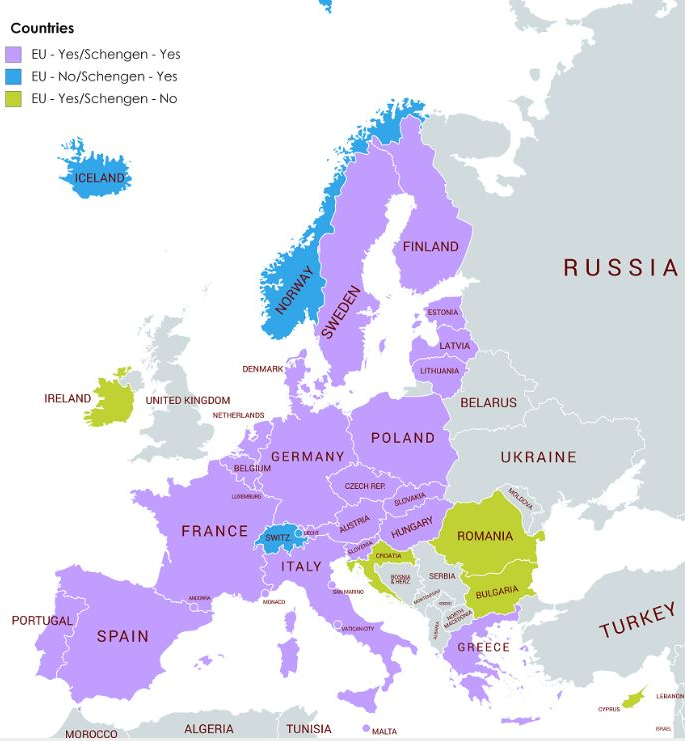The Schengen area includes 26 European states; 22 states of the European Union and 4 associated member states of the European Free Trade Association (EFTA). These countries have abolished internal border controls, so that they can be freely crossed from one border to another without passports and controls.
The special European zone was created in 1985 with the Schengen Agreement (Luxembourg) and began to function officially in 1995. In migration terms, the zone works as a single state, with a common border and visa policy.
The Schengen area should not be confused with the territories of the European Union, since there are member countries of the EU that do not belong to the border-free zone:
- Bulgaria
- Romania
- Croatia
- Cyprus
- Ireland
While there are other states that despite not being members of the EU, they are part of the Schengen area:
- Norway
- Switzerland
- Iceland
- Liechtenstein
Free movement between states in the Schengen area can be temporarily suspended in exceptional circumstances, as has already happened with the attacks in Paris or the migration crisis. Currently, some countries like Austria have border controls with other Schengen states.
Member countries of the Schengen area and their capital cities:
| Country | Capital | |
| 1 | Germany | Berlin |
| 2 | Austria | Vienna |
| 3 | Belgium | Brussels |
| 4 | Denmark | Copenhagen |
| 5 | Slovakia | Bratislava |
| 6 | Slovenia | Ljubljana |
| 7 | Spain | Madrid |
| 8 | Estonia | Tallinn |
| 9 | Finland | Helsinki |
| 10 | France | Paris |
| 11 | Greece | Athens |
| 12 | Hungary | Budapest |
| 13 | Iceland | Reykjavik |
| 14 | Italy | Rome |
| 15 | Latvia | Riga |
| 16 | Liechtenstein | Vaduz |
| 17 | Lithuania | Vilnius |
| 18 | Luxembourg | Luxembourg |
| 19 | malt | Valletta |
| 20 | Norway | Oslo |
| 21 | Netherlands | Amsterdam |
| 22 | Poland | Warsaw |
| 23 | Portugal | Lisbon |
| 24 | Czech Republic | Prague |
| 25 | Sweden | Stockholm |
| 26 | Switzerland | Bern |
Source: Schengen Visa Info
Travel restrictions due to COVID-19
Following the outbreak of coronavirus the European Council unanimously agreed on sweeping restrictions on travel to the Schengen area. Any ‘non-essential’ movements across the external Schengen borders are suspended. This decision followed a week of political activism across Europe to fight the epidemic, including temporary border controls and far-reaching travel restrictions at the internal borders between several Member States.
It is essential to differentiate border controls from travel restrictions. While the former are fairly unproblematic in case of a pandemic, the latter raise important legal questions. Notwithstanding the EU’s commitment to the Schengen area, physical border controls have become a common phenomenon over the past five years. Even before the current pandemic, six Member States including France, Sweden and Austria had reinstated controls at some segments of their borders. The Czech Republic, Denmark, Hungary, Poland, Estonia, Lithuania, Norway, Germany and Switzerland followed suit or extended existing controls in 2020, while Slovakia announced medical checks in the border area.
